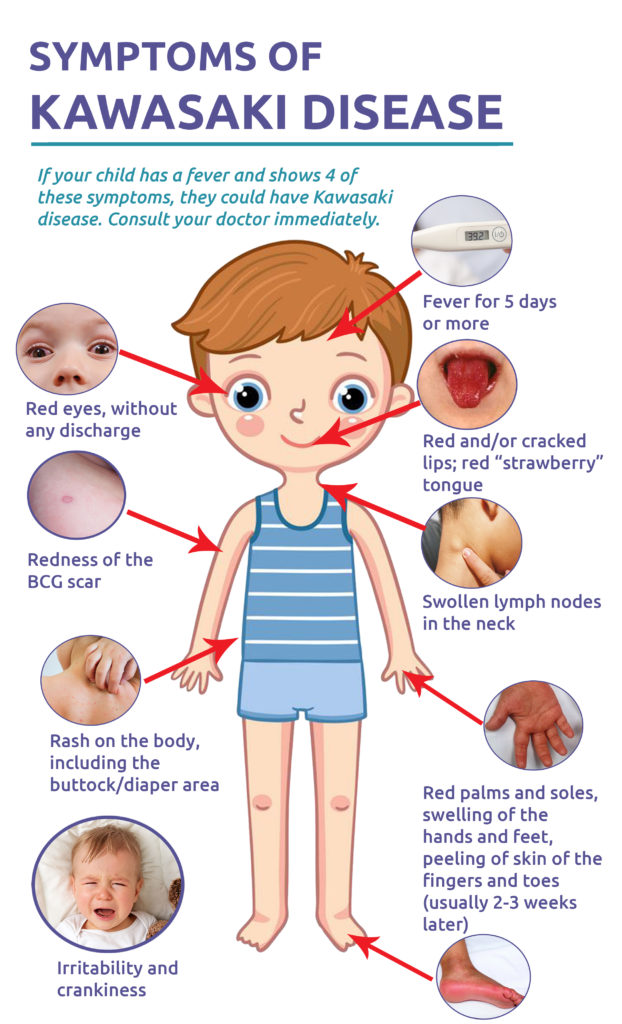Do you know the symptoms of Kawasaki Disease? Learn how to recognize and care for this rare childhood illness here.
Table of Contents
- Introduction: Exploring Kawasaki Disease
- What is Kawasaki Disease?
- Signs and Symptoms
- Causes of Kawasaki Disease
- Diagnosing Kawasaki Disease
- Treating Kawasaki Disease
- Possible Complications
- Prevention and Care
- Living with Kawasaki Disease
- Support and Resources
- Conclusion: Embracing Healthy Living
- FAQs About Kawasaki Disease
Introduction: Exploring Kawasaki Disease
Have you ever heard of Kawasaki disease? It’s important to understand this pediatric health issue to ensure the well-being of children. Let’s explore what Kawasaki disease is all about and why it matters.
Kawasaki disease is a condition that can affect kids, causing inflammation in the body. This means that certain parts of the body become red, swollen, and painful. It’s crucial for parents and doctors to recognize the signs of Kawasaki disease early to provide the necessary care.
By learning more about Kawasaki disease, we can help children stay healthy and receive the treatment they need. Let’s dive into the details of this condition and why it’s essential to pediatric health.
What is Kawasaki Disease?
Kawasaki Disease is a type of inflammation that affects kids. When we talk about inflammation, we are referring to the body’s immune response. This means that when the body detects an injury or infection, it sends out cells to help fight off the problem. In the case of Kawasaki Disease, this immune response goes a bit haywire and causes inflammation in the body.
Understanding Inflammation
Inflammation is the body’s way of protecting itself from harmful things like bacteria and viruses. When you get a cut or a scrape, inflammation helps to heal the wound. However, in Kawasaki Disease, this process happens on a larger scale inside the body, leading to symptoms like fever, rash, and swollen hands and feet.
The Link to Pediatric Health
Because Kawasaki Disease mainly affects children, it is considered a pediatric health issue. The symptoms and complications of this disease can be more severe in kids, which is why it’s essential for parents and doctors to be aware of the signs and treat it promptly.
Signs and Symptoms
If you or someone you know has Kawasaki Disease, there are some signs to look out for. Common symptoms include a fever that lasts for more than five days, a rash, redness of the eyes, swollen hands and feet, and peeling skin on the hands and feet. Sometimes, children with this disease may have red or cracked lips, a swollen tongue, and enlarged lymph nodes in their neck.

Image courtesy of healthwaymedical.com via Google Images
When to See a Doctor
It’s essential to pay attention to these symptoms and seek medical help if you notice them in yourself or someone else. If a fever persists, especially if it goes on for more than five days, or if a child is experiencing any of the other symptoms mentioned, it’s crucial to see a doctor as soon as possible. Early detection and treatment of Kawasaki Disease are key to preventing more severe complications.
Causes of Kawasaki Disease
When it comes to understanding Kawasaki Disease, it’s essential to explore the potential causes behind this condition. While the exact reason why some children develop Kawasaki Disease is still unknown, researchers believe that it is linked to the body’s immune response.
The Immune Response Connection
Our immune system is like a superhero defending our bodies against harmful invaders like bacteria and viruses. Sometimes, our immune system might get a little too overactive and start attacking healthy tissues by mistake. This mistaken attack can lead to inflammation, which is a crucial aspect of Kawasaki Disease.
In Kawasaki Disease, the immune response goes into overdrive, causing inflammation in the blood vessels throughout the body. This inflammation can affect various organs, with a particular focus on the heart. The inflammation can lead to the classic symptoms of the disease, like fever, rash, red eyes, and swollen hands and feet.
While researchers are still trying to unravel the mystery behind why the immune system behaves this way in Kawasaki Disease, understanding this immune response connection can shed light on how this condition manifests and progresses in young children.
Diagnosing Kawasaki Disease
Diagnosing Kawasaki Disease involves a series of medical tests and examinations to accurately identify this pediatric health condition. Doctors rely on specific procedures to confirm the presence of this inflammatory disease in children.

Image courtesy of www.shutterstock.com via Google Images
Medical Tests and Examinations
When a child exhibits symptoms suggestive of Kawasaki Disease, healthcare providers may conduct several tests to make a diagnosis. One crucial test is measuring the child’s temperature regularly to track any fever spikes, which is a common symptom of the disease. Blood tests are also utilized to detect elevated levels of certain markers that indicate inflammation in the body.
Another critical examination is an echocardiogram, which is a type of ultrasound that provides detailed images of the heart. This test is essential because Kawasaki Disease can lead to heart complications if left untreated. The echocardiogram helps doctors assess the condition of the heart and monitor any abnormal changes that may occur as a result of the disease.
In some cases, doctors may also perform a test called a chest X-ray to check for any signs of heart inflammation or other complications related to Kawasaki Disease. These diagnostic tools help medical professionals make informed decisions about the appropriate treatment plan for children affected by this condition.
Treating Kawasaki Disease
When a child is diagnosed with Kawasaki Disease, it is crucial to start treatment promptly. Let’s delve into the various options available to help manage this condition and promote your child’s recovery.
Medical Treatments
Doctors may prescribe medications to reduce inflammation in the body and alleviate the symptoms of Kawasaki Disease. These medications can help prevent complications and minimize the risk of long-term heart issues.
Intravenous immunoglobulin (IVIG) is a common treatment for Kawasaki Disease. This therapy involves receiving antibodies through a vein to help regulate the immune response and reduce inflammation. Aspirin may also be recommended to lower fever and reduce the risk of blood clotting.
Regular follow-up appointments are essential to monitor your child’s progress and adjust their treatment plan as needed. By working closely with healthcare providers, you can ensure that your child receives the best care possible for Kawasaki Disease.
Possible Complications
One of the possible complications of Kawasaki Disease is its impact on the heart. If left untreated or not properly managed, this condition can lead to heart issues. The inflammation caused by Kawasaki Disease can affect the walls of the blood vessels, including those around the heart. This can result in the development of heart conditions, such as coronary artery abnormalities.

Image courtesy of www.mdpi.com via Google Images
Coronary artery abnormalities involve changes in the blood vessels that supply oxygen-rich blood to the heart muscle. These abnormalities can increase the risk of heart problems, such as heart attacks or heart failure, later in life. Therefore, it is crucial to monitor and address any heart-related complications that may arise from Kawasaki Disease.
Prevention and Care
When a child is diagnosed with Kawasaki Disease, it’s essential to provide them with the utmost care and support. Here are some tips on how to help them through this challenging time:
1. Follow the treatment plan outlined by the healthcare provider diligently. This may include medications, therapies, and regular follow-up appointments.
2. Keep a close eye on the child’s symptoms and any changes in their condition. If you notice anything unusual or concerning, don’t hesitate to contact their healthcare provider.
3. Ensure the child gets plenty of rest and stays hydrated. Rest is crucial for recovery, and hydration helps support overall health and well-being.
4. Help the child stay comfortable by providing a calm and soothing environment. Encourage them to engage in activities that bring them joy and relaxation.
5. Be patient and understanding. Dealing with Kawasaki Disease can be challenging for both the child and their caregivers. Offer emotional support and reassurance throughout the treatment process.
By being proactive in caring for a child with Kawasaki Disease, you can help them navigate this illness with resilience and strength.
Living with Kawasaki Disease
Living with Kawasaki Disease can bring changes to a child’s life and impact the entire family. Here are some insights into what to expect and how to navigate this condition.

Image courtesy of www.facebook.com via Google Images
Changes in Daily Life
After a child is diagnosed with Kawasaki Disease, they may need to follow a treatment plan that includes medications and regular check-ups with doctors. This means more frequent visits to the hospital or clinic, which can disrupt the normal routine.
| Symptom | Description | Care |
|---|---|---|
| Fever | High fever lasting more than 5 days | Monitor temperature regularly and provide fever-reducing medications |
| Rash | Red, raised rash on the trunk and genitals | Keep skin clean and dry, use mild lotions to soothe itching |
| Red Eyes | Conjunctivitis or redness in both eyes | Clean eyes with a damp cloth and consult with a healthcare provider |
| Swollen Hands and Feet | Swelling and redness in the hands and feet | Elevate hands and feet, encourage rest and hydration |
| Swollen Lymph Nodes | Enlarged lymph nodes in the neck | Apply warm compresses to alleviate discomfort |
Parents may also need to monitor their child’s symptoms closely and be prepared to act quickly if there are any signs of worsening condition. This heightened awareness and vigilance can be stressful for families, but it is essential for managing Kawasaki Disease effectively.
Emotional Impact
Living with a chronic illness like Kawasaki Disease can also take an emotional toll on children and their families. Kids may struggle to understand why they are different from their peers or why they need special care. It’s essential for parents and caregivers to provide emotional support and reassurance during this challenging time.
Families may also feel overwhelmed by the demands of caring for a child with Kawasaki Disease. It’s important to lean on support networks, such as friends, family, and healthcare professionals, for assistance and guidance.
Adapting to New Normal
As families adjust to life with Kawasaki Disease, they may find that certain activities need to be modified or avoided to protect the child’s health. This can include changes in diet, exercise restrictions, or precautions to prevent infections.
Despite these challenges, many children with Kawasaki Disease go on to lead healthy, active lives with the right treatment and support. It’s crucial to focus on the positive aspects of life and celebrate small victories along the way.
Support and Resources
Dealing with Kawasaki Disease can be challenging, but you are not alone. There are numerous support groups and resources available to help you navigate this journey.
Support Groups
Joining a support group can connect you with other families who are going through similar experiences. These groups offer a safe space to share stories, ask questions, and find comfort in knowing that you are not alone. Online platforms, such as social media groups or forums, can be a great way to connect with others, even if you are unable to attend in-person meetings.
Medical Professionals
Your child’s healthcare team is a crucial resource in managing Kawasaki Disease. They can provide you with information, guidance, and support throughout your child’s treatment journey. Don’t hesitate to reach out to your doctor or specialist if you have any questions or concerns.
Educational Resources
There are various educational resources available to help you better understand Kawasaki Disease and how to care for your child. Websites, books, and pamphlets can provide valuable information on symptoms, treatments, and lifestyle adjustments that may be necessary. Stay informed and empowered by accessing reliable resources.
Counseling Services
Dealing with a chronic illness like Kawasaki Disease can take a toll on both the patient and their family. Counseling services can offer emotional support and coping strategies to help you navigate the emotional challenges that come with a medical diagnosis. Consider seeking professional help if you feel overwhelmed or distressed.
Remember, while Kawasaki Disease may pose challenges, there are numerous resources available to support you and your child every step of the way. Don’t hesitate to reach out for help and guidance whenever you need it.
Conclusion: Embracing Healthy Living
In conclusion, understanding and addressing health issues like Kawasaki disease are vital for promoting overall well-being, especially in children. By recognizing the signs and symptoms early, seeking appropriate medical care, and following through with necessary treatments, we can support our children in leading healthier lives.

Image courtesy of www.facebook.com via Google Images
It is crucial to remember that conditions like Kawasaki disease can have serious implications, including heart conditions, if left untreated. Therefore, being proactive in seeking medical attention and adhering to treatment plans is essential for the long-term health of our young ones.
Embracing healthy living involves not only managing the specific condition but also adopting a holistic approach to wellness. This includes maintaining a balanced diet, engaging in regular physical activity, getting adequate rest, and reducing stress levels. These practices can contribute to better overall health and immune system function, which is particularly important for children with pediatric health issues like Kawasaki disease.
By staying informed, staying vigilant about symptoms, and actively participating in the care and well-being of our children, we can help them navigate health challenges like Kawasaki disease with resilience and strength. Together, let’s prioritize the health and wellness of our little ones, supporting them in leading vibrant and fulfilling lives.
FAQs About Kawasaki Disease
Kawasaki disease
What is Kawasaki Disease?
Kawasaki Disease is an illness that mainly affects children under the age of five. It causes inflammation in the walls of the arteries throughout the body.
Pediatric Health
How does Kawasaki Disease impact pediatric health?
Since Kawasaki Disease primarily affects young children, it is crucial to understand its symptoms and seek prompt medical attention for appropriate care.
Inflammation
Why does Kawasaki Disease cause inflammation?
Kawasaki Disease triggers the body’s immune response, leading to inflammation in the blood vessels. This can result in various symptoms and complications if left untreated.
Immune Response
How is Kawasaki Disease linked to the immune response?
Kawasaki Disease is believed to be caused by an abnormal immune system response to an infection or trigger. This response can cause inflammation and affect the arteries in the body.
Heart Conditions
What heart conditions can arise from Kawasaki Disease?
If Kawasaki Disease is not properly treated, it can lead to complications affecting the heart. This underscores the importance of early detection and intervention.





